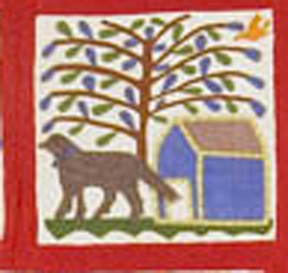Detail of Circle of Friends
Machine Quilted by Deb Jacobs
Period guidelines for quilting designs aren't easy because we quilt and use fabric so differently than the quilters of 150 years ago. Deb's machine quilting on the long arm machine as in my gift quilt above shows some of today's virtuoso quilting. Feathers are a traditional design but the way she arranged them across the surface of a scrappy sampler quilt is very up-to-date.
This sampler quilt from the mid 19th century would probably have been considered scrappy. The biggest difference is the use of white which gave the quilter a place to show off.
Although the more typical example has quilting that is not very dramatic. This detail from a quilt dated 1863 shows the quilting design...
See more about this quilt which belongs to the Historical Society of Nyack NY here:
http://barbarabrackman.blogspot.com/2011/08/civil-war-survivor.html
This outline quilting is not a clue to date. It's common over the centuries in all different eras. It's a style that works better for hand quilting than for long-arm quilting.
Here's a detail of a Civil War-era quilt from Tennessee that shows outline quilting in the patchwork and then a grid in the white areas. See more of this quilt by Mary High Prince at the Quilt Index here:
Another grid in the blue field on one of those Peterson's Magazine flag quilts.
But here the grid is a triple line. The idea of double and triple line quilting, whether grids or diagonal lines, is very 19th century. The stars are outline quilted and notice the pretty little leaf and vine in the stripe. Also notice there is no filler quilting behind that leaf and vine.
Close quilting is the rule---the stitches per inch are not so important as the lines per inch. This grid is probably 1/2" apart or less.
Here's a quilt with a hodge-podge of designs but fairly consistent triple diagonal lines in the border background. This quilter did echo quilting inside the applique, repeating the red diamond shape three times to give a close-quilted look.
Triple diagonal line quilting is very typical, particuarly in borders.



















.jpg)























